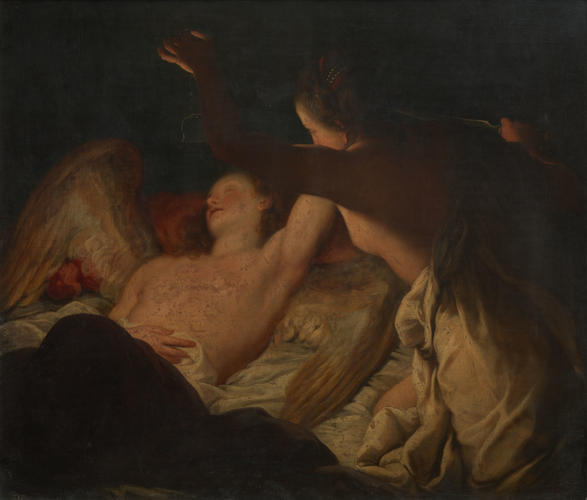-
1 of 253523 objects
Psyche Discovering the Sleeping Cupid c.1710-20
Oil on canvas | 116.6 x 135.4 cm (support, canvas/panel/stretcher external) | RCIN 402783

Italian School, Venetian, early 18th century
Psyche Discovering the Sleeping Cupid c.1710-20

Italian School, Venetian, early 18th century
Psyche Discovering the Sleeping Cupid c.1710-20


-
The scene is dramatically lit by the lamp held up by Psyche. On the bed at the left lies Cupid, deeply asleep, with one arm above his head and the other on his stomach. In the shadows at the right kneels Psyche; she holds the lamp in her left hand and a long dagger in her right. The painting depicts an incident from the tale of the lovers Cupid and Psyche, told in The Golden Ass by the second-century AD writer Apuleius and well known in translations in later centuries. Cupid and Psyche had been married under cover of darkness, and Cupid continued to visit Psyche each night without revealing his true identity. Psyche's jealous sisters convinced her that her suitor was a terrible serpent, and advised her to conceal an oil lamp and a knife in her bedchamber with which to slay him. This painting shows the moment that Psyche recognizes the fair form on the bed as the god Cupid himself. Apuleius described Cupid sleeping while Psyche illuminates his beautiful youthful figure with her lamp:
'a milk-white neck, and rosy cheeks over which there strayed coils of hair becomingly arranged, some hanging in front, some behind, shining with such extreme brilliance that the lamplight itself flickered uncertainly. On the shoulders of the flying god wings sparkled dewy-white with glistening sheen, and though they were at rest the delicate down at their edges quivered and rippled in incessant play. The rest of the god's body was smooth and shining and such as Venus need not be ashamed of in her son. At the foot of the bed lay a bow, a quiver and arrows, the gracious weapons of the great god.'
The artist of this work is unknown, but it seems to be by a Venetian painter trained in the seventeenth century but working in the eighteenth. The painters Gregorio Lazzarini (1655-1730) or Antonio Bellucci (1654-1726) have been suggested; a painting of the same subject by Bellucci, very different in concept and composition, is in the Alte Pinakothek, Munich. Bellucci was active in England c. 1716, which may explain how the picture entered the royal collection.Provenance
First recorded in the Great Room of the Library at Buckingham Palace in 1790 as 'Lazarino'; moved from here to Windsor Castle in 1805 and recorded in the Council Chamber at Windsor in 1816, still as 'Lazarino', meaning Gregorio Lazzarini
-
Creator(s)
-
Medium and techniques
Oil on canvas
Measurements
116.6 x 135.4 cm (support, canvas/panel/stretcher external)
136.3 x 155.8 x 7.5 cm (frame, external)
Category
Object type(s)